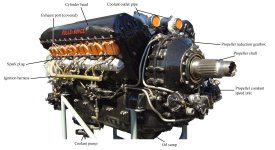Немного из истории
Automotive
Michael Wilcock of Sussex, England built the Swandean Spitfire Special, using a Merlin XXV engined acquired from a a scrap yard for fifty pounds. The engine was installed in a home-brewed chassis confected from two Daimler Dingo scout car chassis. The car was run in the Brighton Speed Trials in 1953, and was sold to James Duffy of St. Louis, Missouri in 1956. As of 2005, the vehicle is still in St. Louis, where it is undergoing restoration.
In the 1960s, Paul Jameson put a Merlin engine (some say it actually was a Rover-built Rolls-Royce Meteor, which was a de-tuned Merlin without superchargers and with steel components replacing some aluminium ones) into a chassis he had built himself. He did not get around to building a body, and sold the car to Epsom automatic transmission specialist John Dodd, who fitted a fibreglass body based on the shape of the Ford Capri and named the machine "The Beast". Originally it had a grille from a Rolls-Royce, but after complaints from R-R themselves he had to change it. According to Dodd's account, he once drove past a Porsche driver on the autobahn who then called Rolls Royce asking about their "new model". The Beast was once listed in the Guinness Book of Records as the world's most powerful road car. The engine came from a Boulton Paul Balliol training aircraft which would give 1,262 hp (941 kW) at 8,500 feet (2,600 m). No supercharger was fitted to the engine in car so it "only" delivered about 850 hp (630 kW). The car used a General Motors TH400 automatic transmission. The Beast is alive and well in Marbella, Spain and is still owned by Dodd. It is still taxed in the UK; a DVLA search shows the engine capacity as 27000cc.
In the mid-1970s, Jameson designed a second Merlin-powered car. This one had six wheels - two in front and four driven at the rear - and a mid-engined layout. The vehicle was featured by the British weekly motoring magazine "Motor"), and is said currently to reside in a museum in Sweden.
Around 1990, Jameson began work on a third Merlin-powered car, using a genuine 1930s Rolls-Royce chassis, but this vehicle remained uncompleted at the time of his death.
Recently in Australia, Rod Hadfield, of the Castlemaine Rod Shop, used the Merlin engine in a 1955 Chevrolet BelAir Sports Coupe, which was named "Final Objective."[1]
[edit]
Boat racing
In the mid-forties and early fifties, aviation engines gained in popularity as powerplants of choice for hydroplane racing, given their relatively high power-to-weight ratio, reliability and availability. Starting with the MISS WINDSOR raceboat at Detroit in 1946, several ever-more-powerful variants of the Merlin were so used, over the next decades, in a heated battle against the equally popular Allison V-1710. In unlimited hydroplane racing, both were eventually supplanted by gas turbine engines, which exhibit even more favourable power-to-size and power-to-weight ratios.
[edit]
Variants
This is an incomplete list of representative Merlin variants. Engines of the same power output were typically assigned different model numbers based on supercharger or propeller gear ratios, differences in cooling system or carburetors, engine block construction, or arrangement of engine controls.
Merlin II or III - 1,040 hp (775 kW) at 3,000 rpm at 5,500 ft (1,680 m); used in Spitfire Mk.I and Hurricane Mk.I fighters.
Merlin X - 1,130 hp (840 kW) at 3,000 rpm at 5,250 ft (1,525 m); used in Halifax Mk.I, Wellington Mk.II, and Whitley Mk.V bombers.
Merlin XX - 1,480 hp (1,105 kW) at 3,000 rpm at 6,000 ft (1,830 m); used in Hurricane Mk.II and Beaufighter Mk.II fighters, Halifax Mk.II and Lancaster Mk.I bombers. Also in the P-51 Mustang fighter.
Merlin 32 - 1,645 hp (1,230 kW) at 3,000 rpm at 2,500 ft (760 m); used in Barracuda Mk.II bomber.
Merlin 45 - 1,470 hp (1,100 kW) at 3,000 rpm at 9,250 ft (2,820 m); used in Spitfire Mk.V
Merlin 46 - 1,415 hp (1,055 kW) at 3,000 rpm at 14,000 ft (4,270 m); high-altitude version used in Spitfire PR.Mk.IV and PR.Mk.VII
Merlin 61 - fitted with a new two-speed two-stage supercharger providing 1,565 hp (1,170 kW) at 3,000 rpm at 12,250 ft (3,740 m), and 1,390 hp (1,035 kW) at 3,000 rpm 23,500 ft (7,170 m); high-altitude version used in Spitfire Mk.VII, Mk.VIII, Mk.IX, and PR.Mk.XI
Merlin 76 & 77 - 1,233 hp (920 kW); used in the Westland Welkin high-altitude fighter and some later Spitfire and Mosquito variants. Fitted with a two-speed, two-stage supercharger and a Bendix-Stromberg carburettor. The odd-numbered mark drove a blower for pressurising the cockpit.
[edit]
Specifications (Merlin 61)
Rolls-Royce Merlin with some components labeled. Click image for a larger version.
General characteristics
Type: 12-cylinder supercharged liquid-cooled 60° "Vee" piston aircraft engine
Bore: 5.4 in (137.2 mm)
Stroke: 6 in (152.4 mm)
Displacement: 1,647 in³ (27 L)
Dry weight: 1,640 lb (745 kg)
Components
Valvetrain: Overhead camshaft-actuated, two intake and two exhaust valves per cylinder, sodium-cooled exhaust valve stems
Supercharger: Two-speed two-stage, boost pressure automatically linked to the throttle, water-air aftercooler installed between the second stage and the engine.
Fuel system: Twin-choke updraft carburetor with automatic mixture control
Oil system: Dry sump with one pressure pump and two scavenge pumps.
Cooling system: 70% water and 30% ethylene glycol coolant mixture, pressurized.
Performance
Power output:
1,565 hp (1,170 kW) at 3,000 rpm at 12,250 ft (3,740 m)
1,390 hp (1,035 kW) at 3,000 rpm at 23,500 ft (7,170 m)
Specific power: 0.95 hp/in³ (43.3 kW/L)
Compression ratio: 6:1
Power-to-weight ratio: 0.95 hp/lb (1.57 kW/kg)

![92eef756[1].jpg](/phorum/data/attachments/5/5078-47db44791e75a081c2f30a0cf9ea306a.jpg)
![b396062e[1].jpg](/phorum/data/attachments/5/5079-da37a43eeef53ead6c3986f56c195d9f.jpg)
